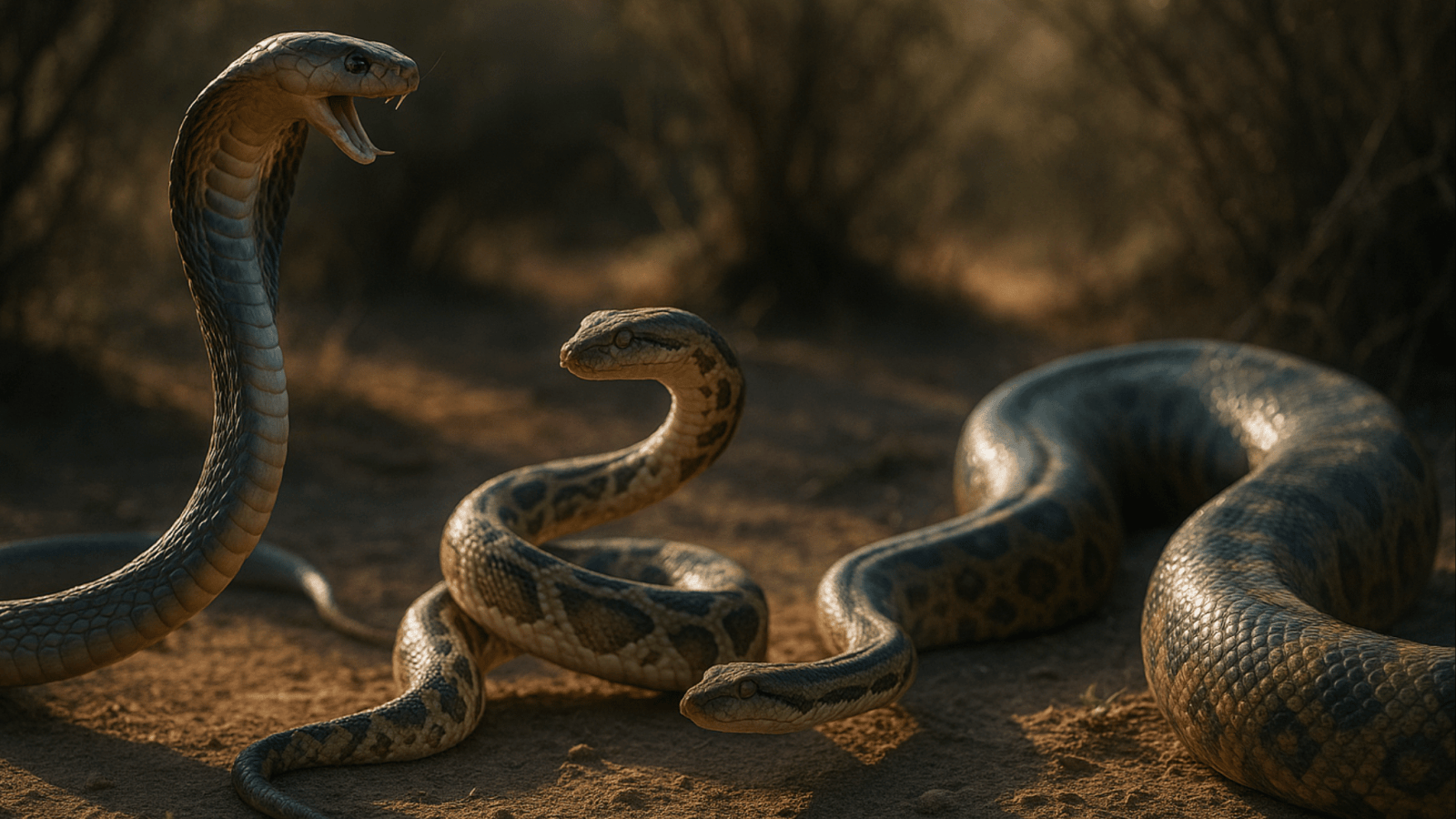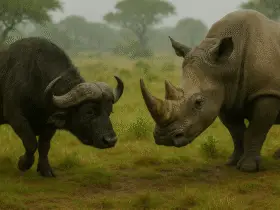What if a fight between the iconic serpents Cobra vs Python vs Anaconda. Its a reptilian battle of strength, venom, and survival. Each snake rules in its own ecological environment: the venomous cobra with its intimidating hood, the muscular python known for constriction, and the aquatic powerhouse anaconda. But in a hypothetical battle, which would come out on top? This in-depth comparison will explain 10 scientific categories to get the final winner of the: cobra vs python vs anaconda.
Keep reading Till the end! Enjoy!
1. Body Specifications
| Subtopic | Cobra | Python | Anaconda | Winner |
|---|---|---|---|---|
| Average Length (m) | 1.5–3 m | 4–6 m | 4–6 m (females up to 7 m) | Anaconda |
| Average Weight (kg) | 6–9 kg | 30–50 kg | 100–250 kg | Anaconda |
| Skull Shape | Narrow, slightly elongated | Broad | Very broad | Anaconda |
| Bone Density | Light | Moderate | High | Anaconda |
| Body Girth | Slender | Thick | Extremely thick | Anaconda |
| Tail Length | 0.2–0.4 m | 0.5–1 m | 0.6–1.2 m | Anaconda |
| Scale Type | Smooth | Keeled | Smooth | Draw |
| Hood Presence | Yes | No | No | Cobra |
| Thermoregulation | Ectothermic | Ectothermic | Ectothermic | Draw |
| Category Winner | Anaconda |
2. Venom Characteristics
| Subtopic | Cobra | Python | Anaconda | Winner |
|---|---|---|---|---|
| Venom Type | Neurotoxic | Non-venomous | Non-venomous | Cobra |
| Venom Potency (LD50) | 0.2–0.5 mg/kg (subcut.) | N/A | N/A | Cobra |
| Venom Yield (mg) | 150–350 mg | N/A | N/A | Cobra |
| Delivery System | Fixed front fangs | None | None | Cobra |
| Envenomation Speed | Fast | N/A | N/A | Cobra |
| Defense Mechanism | Hood display + bite | Constriction | Constriction | Cobra (venom) |
| Impact on Prey | Rapid paralysis | Suffocation | Drowning & suffocation | Draw |
| Antivenom Availability | High | N/A | N/A | Cobra |
| Reusability of Venom | Moderate | N/A | N/A | Cobra |
| Category Winner | Cobra |
3. Physical Power and Bite
| Subtopic | Cobra | Python | Anaconda | Winner |
|---|---|---|---|---|
| Bite Force (PSI) | ~70 PSI | ~200 PSI | ~400 PSI | Anaconda |
| Constriction Pressure | None | 7–15 PSI per coil | 30+ PSI per coil | Anaconda |
| Fang Length (mm) | 8–12 mm | Small rear teeth | Small rear teeth | Cobra |
| Bite Precision | High | Moderate | Moderate | Cobra |
| Striking Speed | Fast | Moderate | Slow | Cobra |
| Jaw Gape | 70–80° | 130° | 150° | Anaconda |
| Muscle Mass | Moderate | High | Very high | Anaconda |
| Neck Strength | Weak | Moderate | Strong | Anaconda |
| Bite Durability | Low | High | High | Draw |
| Category Winner | Anaconda |
4. Locomotion and Mobility
| Subtopic | Cobra | Python | Anaconda | Winner |
|---|---|---|---|---|
| Maximum Land Speed (km/h) | 18–20 | 1–2 | 1–2 | Cobra |
| Swimming Ability | Moderate | Moderate | Excellent | Anaconda |
| Climbing Ability | Good | Good | Poor | Cobra/Python |
| Endurance (on land) | Moderate | High | Low | Python |
| Terrain Adaptability | High | High | Medium | Draw |
| Slithering Efficiency | High | Moderate | Low | Cobra |
| Ambush Skill | Moderate | High | High | Python/Anaconda |
| Escape Speed | High | Low | Very Low | Cobra |
| Reaction Time | Very fast | Moderate | Slow | Cobra |
| Category Winner | Cobra |
5. Senses and Intelligence
| Subtopic | Cobra | Python | Anaconda | Winner |
|---|---|---|---|---|
| Vision | Daytime active, color vision | Poor vision | Poor vision | Cobra |
| Heat-Sensing Pits | No | Present | Present | Python/Anaconda |
| Chemoreception | Excellent | Excellent | Excellent | Draw |
| Jacobson’s Organ | Present, well-developed | Present, well-developed | Present, well-developed | Draw |
| Brain-to-Body Ratio | Moderate | Low | Low | Cobra |
| Learning Ability | Moderate | Moderate | Low | Cobra/Python |
| Aggression Level | High | Low–moderate | Moderate | Cobra |
| Tactile Sensitivity | High | Moderate | Moderate | Cobra |
| Reflexes | Very fast | Moderate | Slow | Cobra |
| Category Winner | Cobra |
6. Combat Skills
| Subtopic | Cobra | Python | Anaconda | Winner |
|---|---|---|---|---|
| Ambush Capability | Moderate | High | High | Python/Anaconda |
| Precision Attack | Very high | Moderate | Moderate | Cobra |
| Defensive Tactics | Hood display, venom strike | Coiling/constriction | Ambush constriction | Cobra/Anaconda |
| Offensive Tactics | Strike + retreat | Coiling around prey | Bite and constrict | Anaconda |
| Grappling Strength | Weak | High | Very high | Anaconda |
| Speed of Engagement | Very fast | Moderate | Slow | Cobra |
| Tactical Awareness | Moderate | Moderate | Low | Cobra |
| Fatal Accuracy | High | Moderate | Moderate | Cobra |
| Multiple Opponent Handling | Poor | Moderate | Poor | Python |
| Category Winner | Cobra |
7. Survival and Defense
| Subtopic | Cobra | Python | Anaconda | Winner |
|---|---|---|---|---|
| Camouflage Ability | Moderate | High | High | Python/Anaconda |
| Threat Displays | Hood, hissing, spitting | Coiling defensively | Staying submerged | Cobra |
| Physical Resistance | Moderate | High | Very high | Anaconda |
| Venom as Deterrent | Yes | No | No | Cobra |
| Adaptability | High | High | Medium | Cobra/Python |
| Wound Recovery | Moderate | High | High | Python/Anaconda |
| Escape Strategy | Speed | Hiding | Water retreat | Cobra |
| Predator Avoidance | Intimidation | Camouflage | Aquatic hiding | Draw |
| Risk Management | High | Moderate | Low | Cobra |
| Category Winner | Cobra |
8. Habitat and Distribution
| Subtopic | Cobra | Python | Anaconda | Winner |
|---|---|---|---|---|
| Geographic Range | Africa, Asia | Africa, Asia, Australia | South America | Python |
| Habitat Diversity | Forests, grasslands, farms | Forests, grasslands | Swamps, rivers | Python |
| Climate Adaptability | Tropical, arid | Wide (tropical to semi-arid) | Limited (humid only) | Python |
| Elevation Range | Up to 2,000 m | Up to 2,500 m | < 1,000 m | Python |
| Range Overlap | Yes (with python) | Yes (with cobra) | Rare | Python |
| Deforestation Tolerance | Moderate | Moderate–High | Low | Python |
| Urban Tolerance | High | Medium | Low | Cobra |
| Water Dependency | Low | Medium | Very high | Cobra/Python |
| Niche Specialization | Moderate | Broad | Narrow | Python |
| Category Winner | Python |
9. Reproductive Traits
| Subtopic | Cobra | Python | Anaconda | Winner |
|---|---|---|---|---|
| Reproduction Type | Oviparous (eggs) | Oviparous | Ovoviviparous (live birth) | Anaconda |
| Mating Rituals | Combat between males | Male competition | Similar | Draw |
| Parental Care | Female guards eggs | Female incubates eggs | No parental care | Python |
| Hatchling Survival | Moderate | Moderate | High (born developed) | Anaconda |
| Clutch Size | 10–30 | 20–100 | 20–40 | Python |
| Gestation Period | 2 months | 2–3 months | ~6–7 months | Cobra/Python |
| Reproductive Frequency | Annual | Annual | Biennial | Cobra/Python |
| Egg Incubation Temp. | 28–32°C | 30–33°C | N/A (live birth) | Python |
| Fecundity | Moderate | High | Moderate | Python |
| Category Winner | Python |
10. Scientific Legacy & Cultural Impact
| Subtopic | Cobra | Python | Anaconda | Winner |
|---|---|---|---|---|
| Scientific Research | Extensive | Extensive | Moderate | Cobra/Python |
| Cultural Symbolism | Sacred in India, Egypt | Mythical size, strength | Feared, exaggerated | Cobra |
| Media Representation | Frequent (movies, docu) | Common | Very common (horror) | Anaconda |
| Mythical Status | Naga, Sheshnag, etc. | Serpent myths | Monster legends | Cobra/Anaconda |
| Medicinal Research | Venom used in pharma | None | None | Cobra |
| Fear Factor | Very high | Moderate | High | Cobra |
| Pop Culture Presence | Very high | High | High | Cobra |
| National Symbol | Yes (India, Thailand) | No | No | Cobra |
| Conservation Efforts | Active | Active | Limited | Cobra/Python |
| Category Winner | Cobra |
Interesting Facts – Cobra vs Python vs Anaconda
Cobra
-
Longest venomous snake, reaching up to 18 feet.
-
Can “stand up” by lifting a third of its body to face threats.
-
Primarily eats other snakes, even venomous ones.
-
Produces a low growl by vibrating its tracheal membrane.
-
Venom attacks the nervous system, causing paralysis.
-
Expands a hood when threatened to appear larger.
-
Highly intelligent; avoids humans when possible.
-
Females guard nests of 20–40 eggs until they hatch.
-
Found in forests across India and Southeast Asia.
-
Skin color varies from olive-green to black with pale bands.
Python
-
Non-venomous constrictors; squeeze prey to death.
-
Reticulated pythons can grow over 30 feet long.
-
Have heat-sensing pits to detect warm-blooded prey.
-
Can unhinge jaws to swallow prey whole.
-
Green tree pythons have over 100 sharp teeth.
-
Females coil around eggs to protect and warm them.
-
Excellent swimmers; some species live near water.
-
Can survive months without food after a large meal.
-
Skin patterns provide camouflage in their habitat.
-
Royal pythons curl into a ball when threatened.
Anaconda
-
Heaviest snake species, weighing up to 550 pounds.
-
Green anacondas can grow over 20 feet long.
-
Live in South American swamps and rivers.
-
Give birth to live young (up to 40 at once).
-
Eat deer, caimans, and even jaguars occasionally.
-
Use water to ambush prey; hunt mostly at night.
-
Pink-tinted sweat acts as natural sunscreen.
-
Females sometimes eat males after mating.
-
Eyes and nostrils on head allow stealthy submerged hunting.
-
Can go weeks without eating after a large meal.
Face-to-Face Fight Analysis
In a direct fight, outcomes vary based on the setting and circumstances:
Cobra vs Python
-
The cobra has venom but lacks size and strength.
-
A python can coil and crush the cobra with a surprise attack.
-
If the cobra lands a venomous bite early, it might escape.
-
Winner: Python (65%) – due to size and constriction strength.
Cobra vs Anaconda
-
The cobra’s venom could be fatal, but the anaconda’s mass and aquatic advantage are overwhelming.
-
In water or even on land, the cobra would struggle to land a killing strike before being overpowered.
-
Winner: Anaconda (75%) – superior strength and bulk dominate.
Python vs Anaconda
-
A more balanced battle. The python is agile and longer, but the anaconda is more powerful.
-
In aquatic or marshy settings, the anaconda wins.
-
On dry land, the python has a slightly better chance to escape and fight back.
-
Winner: Anaconda (60%) – overall physical advantage.
Overall Winner Table
| Category | Cobra | Python | Anaconda |
|---|---|---|---|
| Body Specifications | ❌ | ❌ | ✅ |
| Venom Characteristics | ✅ | ❌ | ❌ |
| Physical Power & Bite | ❌ | ❌ | ✅ |
| Locomotion & Mobility | ✅ | ❌ | ❌ |
| Senses & Intelligence | ✅ | ❌ | ❌ |
| Combat Skills | ✅ | ❌ | ❌ |
| Survival & Defense | ✅ | ❌ | ❌ |
| Habitat & Distribution | ❌ | ✅ | ❌ |
| Reproductive Traits | ❌ | ✅ | ❌ |
| Scientific/Cultural | ✅ | ❌ | ❌ |
| Total Wins | 6 | 2 | 2 |
Final Verdict: Who Would Win in a Fight?
While the cobra dominates in venom, speed, and cultural impact, its small size severely limits its chances in physical combat. The python is agile and powerful, especially on land, but lacks the anaconda’s sheer muscle mass. The anaconda, though not venomous or fast, is nearly unbeatable in raw strength and aquatic ambush tactics.
Winner in a fight: Anaconda
Runner-up: Python
Least likely to win in combat: Cobra
Read More – Black Mamba vs Viper Brutal Scientific Battle – Who Wins?
References
-
Campbell, J. A., & Lamar, W. W. (2004). The venomous reptiles of the Western Hemisphere. Cornell University Press.
-
Greene, H. W. (1997). Snakes: The evolution of mystery in nature. University of California Press.
-
Murphy, J. C., & Henderson, R. W. (1997). Tales of giant snakes: A historical natural history of anacondas and pythons. Krieger Publishing Company.
-
National Geographic. (n.d.). Reptiles. https://www.nationalgeographic.com/animals/reptiles
-
Animal Diversity Web. (n.d.). Naja, Python, and Eunectes species accounts. University of Michigan. https://animaldiversity.org






Amazing !! ❤️